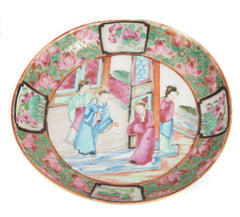Chinese Canton Celadon & Famille Rose Porcelain & Marks
The Canton (Guangzhou) region of China was noted for decorating rather than manufacturing of porcelain. Enamelling began in the early 18th century and the completed items were usually transported to Europe as a secondary cargo onboard tea clippers of the East India companies. Their weight served as ballast for the voyage and gave the merchants another profitable product line along with the tea.
The blanks decorated in Canton were sourced from the kilns at Jingdezhen and were painted with very detailed patterns which were in fashion in the European markets. The celadon grounds were enamelled with people, insects, flowers, fruits etc along with formal pattern work. The main forms are rose medallion (with a central circular medallion), rose mandarin (with people as the main decorative form), rose canton (with birds, flowers fruit and insects) the lesser seen patterns include dragons, fish and cabbages. The colour palette used was generally Famille Rose with occasional variation and gilt was also used, sometimes extensively.
Canton enamelled porcelain was most prolific during the mid 19th century, and as with many items as the popularity grew so did price pressure and simpler more basically decorated examples became common. Production is thought to have slowed due to the 'Long Depression' starting in 1873, however production does seem to continue into the early 20th century. There was also a limited post war revival, and also production in the 1980's. To see our stock of Canton enamelled items click here.
Canton enamelled pieces can be found both marked and unmarked in about equal proportion. Marks are often stylised seal forms rather than true character marks, and these are often based on earlier periods and not true to the date of manufacture - such marks being known as 'apocryphal'. Sometimes the seal marks appear entirely made up. Less common are marks in the form of a symbol rather than characters, these often reusing earlier Chinese forms. Poor quality printed marks and Latin alphabet marks suggest 20th century and post war production.
Examples

|
Chinese Canton porcelain enamelled 'rose canton' plate c1860 Tongzhi era. Marked to the base with a peach and bat Fu Shou symbol - happiness and longevity.
|
 |
Chinese Canton enamelled shaped dish with people and birds in eight panels and a central medallion. Less common famille verte palette. Mid 19th century probably Daoguang. Unmarked. |
 |
Chinese 'rose mandarin' porcelain saucer with people and a floral border. Late 19th century c1870, Tongzhi era. Unmarked. |
Marks
| F | |
 |
Fu Shou: 蝙蝠桃 - Stylised bat and peach mark symbolising happiness and longevity. Probably Xianfeng period. Mark from a rose canton plate. |
| T | |
 |
Tongzhi: Very poorly hand scripted seal mark probably intended as Da Qing Tongzhi Nian Zhi (大庆同治年制) (Made during the Tongzhi Reign of the Great Qing Dynasty). Tongzhi period (1861-75) or slightly later. Mark from a rose canton dish |